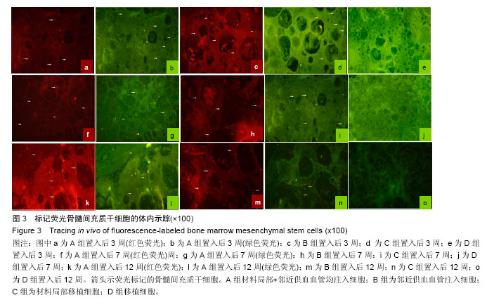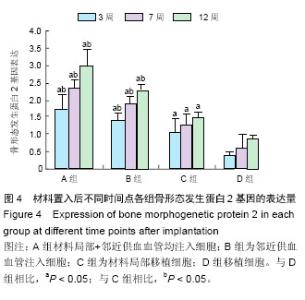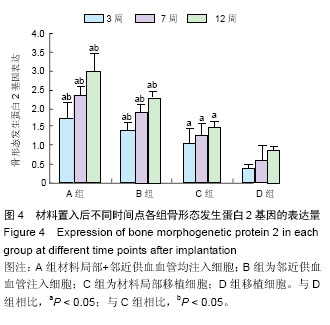Chinese Journal of Tissue Engineering Research ›› 2016, Vol. 20 ›› Issue (25): 3665-3672.doi: 10.3969/j.issn.2095-4344.2016.25.003
Previous Articles Next Articles
Porous calcium phosphate cement induces osteogenesis of mesenchymal stem cells under microenvironment
Mao Xue-qing1, 2, Li Meng2, Li Shao-feng2, Liu Xing-yan2
- 1General Military Orthopedic Institute, Xijing Hospital of the Fourth Military University of Chinese PLA, Xi’an 710032, Shannxi Province, China; 2Department of Orthopedics Center, General Hospital of Lanzhou Military Region of Chinese PLA, Lanzhou 730050, Gansu Province, China
-
Received:2016-04-09Online:2016-06-17Published:2016-06-17 -
Contact:Liu Xing-yan, Professor, Chief physician, Doctoral supervisor, Department of Orthopedics Center, General Hospital of Lanzhou Military Region of Chinese PLA, Lanzhou 730050, Gansu Province, China -
About author:Mao Xue-qing, Studying for master’s degree, General Military Orthopedic Institute, Xijing Hospital of the Fourth Military University of Chinese PLA, Xi’an 710032, Shannxi Province, China; Department of Orthopedics Center, General Hospital of Lanzhou Military Region of Chinese PLA, Lanzhou 730050, Gansu Province, China -
Supported by:the Clinical High-Tech Major Project of Military Hospitals, No. 2010gxjs013; the 12th Five-Year Medical and Health Research Foundation of the PLA, No. CLZ13J003; the Natural Science Foundation of Gansu, No.1208RJZA115; the 12th Five-Year Medical and Health Research Foundation of the Lanzhou Military Region, No. CLZ12JB12
CLC Number:
Cite this article
Mao Xue-qing, Li Meng, Li Shao-feng, Liu Xing-yan. Porous calcium phosphate cement induces osteogenesis of mesenchymal stem cells under microenvironment[J]. Chinese Journal of Tissue Engineering Research, 2016, 20(25): 3665-3672.
share this article

2.2 标记细胞体内示踪观察结果 荧光显微镜观察结果见图3。 A组:在551 nm和490 nm激发光作用下,置入后3周,材料区分别可见发出红色及绿色明亮荧光的标记细胞(箭头表示),红色荧光细胞分布较均匀,绿色荧光细胞材料边缘分布密度大;置入后7周,材料中红色荧光细胞范围变化不大,绿色荧光细胞分布均匀,荧光强度略有减弱;置入后12周,材料中红色和绿色荧光细胞分布已趋均匀,绿色荧光细胞数量少,较红色差异显著, 总体数量较7周时少,荧光强度也较弱。 B组:置入后3,7,12周,551 nm激发光作用下材料区红色荧光标记细胞亮度变化不大,分布趋于均匀。 C组:490 nm激发光作用下材料区绿色荧光标记细胞亮度逐渐减弱,置入后3周荧光标记细胞分散于材料内部周边,置入后7周荧光标记细胞已分布均匀。 D组:各时间节点无荧光显示, "

| [1] Maria-Pau G,Cristina C,Montserrat E,et al.Calcium phosphate cements as drug delivery materials.Science Direct.2012;64(12):1090-1100.[2] Alves Cardoso D,Jansen JA,Leeuwenburgh S.Synthesis and application of nanostruc- tured calcium phosphate ceramics for bone regeneration. J Biomed Mater Res. 2012;11(8):2316-2326.[3] Felix Lanao R,Hoekstra J,Wolke C,et al. Porous calcium phosphate cement for alveolar bone regeneration.J Tissue Eng Regen Med. 2014;8(6):473-482.[4] Zeng D,Xia L,Zhang W,et al.Maxillary sinus floor elevation using a tissue-engineered bone with calcium-magnesium phosphate cement and bone marrow stromal cells in rabbits.Tissue Eng Part A.2011; 18(7-8): 870-881.[5] Liu R,Wu XX,Li J,et al.The promotion of bone tissue regeneration by BMP2-derived peptide P24-loaded calcium phosphate cement microspheres.Ceram Int.2015.[6] Zhang XD,Zou P,Wu C,et al.A study of porous block HA ceramics and it sost eogeneses.In: Bioceramics and the Human Body.ED by Ravaglioli and Krajewski. Elsevier Applied Science,1991:408.[7] Udehiya RK,Amarpal,Aithal HP,et al.Comparison of autogenic and allogenic bone marrow derived mesenchymal stem cells for repair of segmental bone defects in rabbits. Res Vet Sci. 2013;94(3):742-752.[8] Park SY,Kim KH,Shin SY,et al.Dual delivery of rhPDGF-BB and bone marrow mesenchymal stromal cells expressing the BMP2 geneenhance bone formation in a critical-sized defect model.Tissue Eng Part A.2013;19(21-22):2495-2505.[9] Songa G,Habibovicb, PBaoa C,et al.The homing of bone marrow MSCs to non-osseous sites for ectopic bone formation induced by osteoinductive calcium phosphate. Biomaterials.2013;34(9):2167-2176.[10] Phinney DG.Isolation of mesenchymal stem cells from murine bone marrow by immunodepletion.Methods Mol Biol.2008;449:171-186.[11] Park BN,Shim W,Lee G,et al.Early distribution of intravenously injected mesenchymal stem cells in rats with acute brain trauma evaluated by 99m Tc-HMPAO labeling.Nucl Med Biol. 2011;38(8): 1175-1182.[12] Wang PP,Wang JH,Yan ZP,et al.Expression of hepatocyte-like phenotypes in bone marrow stromal cells after HGF induction.Biochem Biophys Res Commun.2004;320(3): 712-716.[13] 张双燕,谢幼专,薛文东,等.塑料包埋技术在骨组织研究中的应用[J].现代临床医学生物工程学杂志, 2007,12(5): 430-432.[14] Rawadi G,Vayssire B,Dunn F,et al.BMP-2 controls alkaline phosphatase expression and osteoblast mineralization by a Wnt autocrine loop.J Bone Miner Res.2003;18(10): 1842-1853.[15] Lee JB,Kuroda S,Shichinohe H,et al.Migration and differentiation of nuclear fluorescence‐labeled bone marrow stromal cells after transplantation into cerebral infarct and spinal cord injury in mice. Neuropathology. 2003;23(3):169-180.[16] Li B,Liao X,Zheng L.Effect of nanostructure on osteoinduction of porous biphasic calcium phosphate ceramics.Acta Biomater.2012;8(10):3794-3804.[17] De Groot J.Carriers that concentrate native bone morphogenetic protein in vivo.Tissue Eng. 1998;4: 337-341.[18] Zhang J,Luo X,Barbieri D,et al The size of surface microstructures as an osteogenic factor in calcium phosphate ceramics.Acta Biomater. 2014;10(7): 3254-3263. [19] Hattori S.Structural features of ectopic bone-like tissue in porous hydroxyapatite blocks.Kokubyo Gakkai Zasshi. 2008,75(2):120-137.[20] Derubeis AR,Cancedda R.Bone marrow stromal cells (BMSCs) in bone engineering: limitations and recent advances.Ann Biomed Eng.2004;32(1):160-165.[21] Sun X,Zhang Z,Wang S,et al.Maxillary sinus floor elevation using a tissue- engineered bone complex with OsteoBone™ and bMSCs in rabbits. Clin Oral Implants Res.2008;19(8):804-813.[22] Jang JH,Castano O,Kim HW.Electrospun materials as potential platforms for bone tissue engineering.Adv Drug Deliv Rev.2009;61(12):1065-1083.[23] Zou D,Zhang Z,He J,et al.Blood vessel formation in the tissue-engineered bone with the constitutively active form of HIF-1α mediated BMSCs.Biomaterials. 2012; 33(7): 2097-2108.[24] 赵天源,孙 红.骨组织工程支架材料及其血管化的研究进程[J].中国组织工程研究,2013, 17(38):6832-6838. [25] Ude CC,Shamsul BS,Ng MH,et al.Bone marrow and adipose stem cells can be tracked with PKH-26 until post staining passage 6 in in vitro and in vivo.Tissue Cell.2012; 44(3):156-163.[26] Yang HN,Park JS,Na K,et al.The use of green fluorescence gene(GFP)-modified rabbit mesenchymal stem cells(rMSCs) coculturedwith chondrocytes in hydrogel constructs to reveal the chondrogenesisof MSCs.Biomaterials.2009;30(31):6374-6385. [27] Li Y,McIntosh K,Chen J,et al.Allogeneic bone marrow stromal cells promote glial–axonal remodeling without immunologic sensitization after stroke in rats.Exp Neurol.2006;198(2):313-325. [28] Taupin P. BrdU immunohistochemistry for studying adult neurogenesis: paradigms, pitfalls, limitations, and validation.Brain Res Rev.2007;53(1):198-214.[29] 金世柱,韩明子,曲波,等.PKH26 荧光示踪剂在小鼠骨髓单个核细胞肝内迁移过程中标记作用的研究[J].胃肠病学和肝病学杂志,2008,17(1):33-35.[30] Nagyova M,Slovinska L,Blasko J,et al.A comparative study of PKH67,DiI,and BrdU labeling techniques for tracing rat mesenchymal stem cells.In Vitro Cell Dev Biol Anim.2014;50(7):656-663. [31] Li M,Liu XY,Liu XD,et al.Creation of macroporous calcium phosphate cements as bone substitutes by using genipin-crosslinked gelatin microspheres.Mater Med. 2009;20(4):925-934. [32] Kasten P,Voge J,Luginbüh R,et al.Influence of platelet-rich plasma on osteogenic differentiation of mesenchymal stem cells and ectopic bone formation in calcium phosphate ceramics.Cells Tissues Organs. 2006;183(2):68-79.[33] Luu HH,Song WX,Luo XJ,et al.Distinct roles of bone morphogenetic proteins in osteogenic differentiation of mesenchymal stem cells.J Orthopaedic Res.2007; 25(5): 665-77.[34] 徐俊,殷潇凡,谷辉杰,等.磷酸三钙填充骨缺损后骨形态发生蛋白和血管内皮生长因子的变化[J].中国组织工程研究,2014,18(43):6959-6965.[35] Gu W,Zhang F,Xue Q,et al.Transplantation of bone marrow mesenchymal stem cells reduces lesion volume and induces axonal regrowth of injured spinal cord. Neuropathology.2010;30(3):205-217.[36] Zhao DC,Lei JX,Chen R,et al.Bone marrow-derived mesenchymal stem cells protect against experimental liver fibrosis in rats.World J Gastroenterol.2005; 11(22): 3431-3440.[37] Tang Z,Wang Z,Qing F,et al.Bone morphogenetic protein Smads signaling in mesenchymal stem cells affected by osteoinductive calcium phosphate ceramics. Biomed Mater Res A. 2015;103(3):1001- 1006. |
| [1] | Pu Rui, Chen Ziyang, Yuan Lingyan. Characteristics and effects of exosomes from different cell sources in cardioprotection [J]. Chinese Journal of Tissue Engineering Research, 2021, 25(在线): 1-. |
| [2] | Lin Qingfan, Xie Yixin, Chen Wanqing, Ye Zhenzhong, Chen Youfang. Human placenta-derived mesenchymal stem cell conditioned medium can upregulate BeWo cell viability and zonula occludens expression under hypoxia [J]. Chinese Journal of Tissue Engineering Research, 2021, 25(在线): 4970-4975. |
| [3] | Zhang Tongtong, Wang Zhonghua, Wen Jie, Song Yuxin, Liu Lin. Application of three-dimensional printing model in surgical resection and reconstruction of cervical tumor [J]. Chinese Journal of Tissue Engineering Research, 2021, 25(9): 1335-1339. |
| [4] | Zhang Xiumei, Zhai Yunkai, Zhao Jie, Zhao Meng. Research hotspots of organoid models in recent 10 years: a search in domestic and foreign databases [J]. Chinese Journal of Tissue Engineering Research, 2021, 25(8): 1249-1255. |
| [5] | Hou Jingying, Yu Menglei, Guo Tianzhu, Long Huibao, Wu Hao. Hypoxia preconditioning promotes bone marrow mesenchymal stem cells survival and vascularization through the activation of HIF-1α/MALAT1/VEGFA pathway [J]. Chinese Journal of Tissue Engineering Research, 2021, 25(7): 985-990. |
| [6] | Shi Yangyang, Qin Yingfei, Wu Fuling, He Xiao, Zhang Xuejing. Pretreatment of placental mesenchymal stem cells to prevent bronchiolitis in mice [J]. Chinese Journal of Tissue Engineering Research, 2021, 25(7): 991-995. |
| [7] | Liang Xueqi, Guo Lijiao, Chen Hejie, Wu Jie, Sun Yaqi, Xing Zhikun, Zou Hailiang, Chen Xueling, Wu Xiangwei. Alveolar echinococcosis protoscolices inhibits the differentiation of bone marrow mesenchymal stem cells into fibroblasts [J]. Chinese Journal of Tissue Engineering Research, 2021, 25(7): 996-1001. |
| [8] | Fan Quanbao, Luo Huina, Wang Bingyun, Chen Shengfeng, Cui Lianxu, Jiang Wenkang, Zhao Mingming, Wang Jingjing, Luo Dongzhang, Chen Zhisheng, Bai Yinshan, Liu Canying, Zhang Hui. Biological characteristics of canine adipose-derived mesenchymal stem cells cultured in hypoxia [J]. Chinese Journal of Tissue Engineering Research, 2021, 25(7): 1002-1007. |
| [9] | Geng Yao, Yin Zhiliang, Li Xingping, Xiao Dongqin, Hou Weiguang. Role of hsa-miRNA-223-3p in regulating osteogenic differentiation of human bone marrow mesenchymal stem cells [J]. Chinese Journal of Tissue Engineering Research, 2021, 25(7): 1008-1013. |
| [10] | Lun Zhigang, Jin Jing, Wang Tianyan, Li Aimin. Effect of peroxiredoxin 6 on proliferation and differentiation of bone marrow mesenchymal stem cells into neural lineage in vitro [J]. Chinese Journal of Tissue Engineering Research, 2021, 25(7): 1014-1018. |
| [11] | Zhu Xuefen, Huang Cheng, Ding Jian, Dai Yongping, Liu Yuanbing, Le Lixiang, Wang Liangliang, Yang Jiandong. Mechanism of bone marrow mesenchymal stem cells differentiation into functional neurons induced by glial cell line derived neurotrophic factor [J]. Chinese Journal of Tissue Engineering Research, 2021, 25(7): 1019-1025. |
| [12] | Duan Liyun, Cao Xiaocang. Human placenta mesenchymal stem cells-derived extracellular vesicles regulate collagen deposition in intestinal mucosa of mice with colitis [J]. Chinese Journal of Tissue Engineering Research, 2021, 25(7): 1026-1031. |
| [13] | Pei Lili, Sun Guicai, Wang Di. Salvianolic acid B inhibits oxidative damage of bone marrow mesenchymal stem cells and promotes differentiation into cardiomyocytes [J]. Chinese Journal of Tissue Engineering Research, 2021, 25(7): 1032-1036. |
| [14] | Guan Qian, Luan Zuo, Ye Dou, Yang Yinxiang, Wang Zhaoyan, Wang Qian, Yao Ruiqin. Morphological changes in human oligodendrocyte progenitor cells during passage [J]. Chinese Journal of Tissue Engineering Research, 2021, 25(7): 1045-1049. |
| [15] | Wang Zhengdong, Huang Na, Chen Jingxian, Zheng Zuobing, Hu Xinyu, Li Mei, Su Xiao, Su Xuesen, Yan Nan. Inhibitory effects of sodium butyrate on microglial activation and expression of inflammatory factors induced by fluorosis [J]. Chinese Journal of Tissue Engineering Research, 2021, 25(7): 1075-1080. |
| Viewed | ||||||
|
Full text |
|
|||||
|
Abstract |
|
|||||







